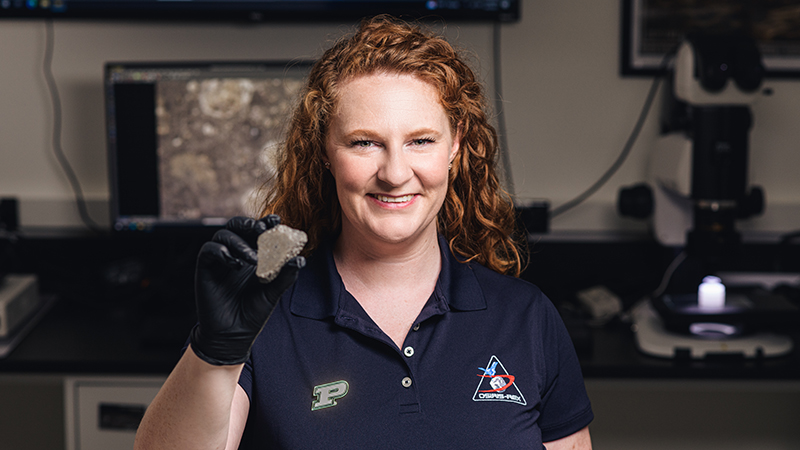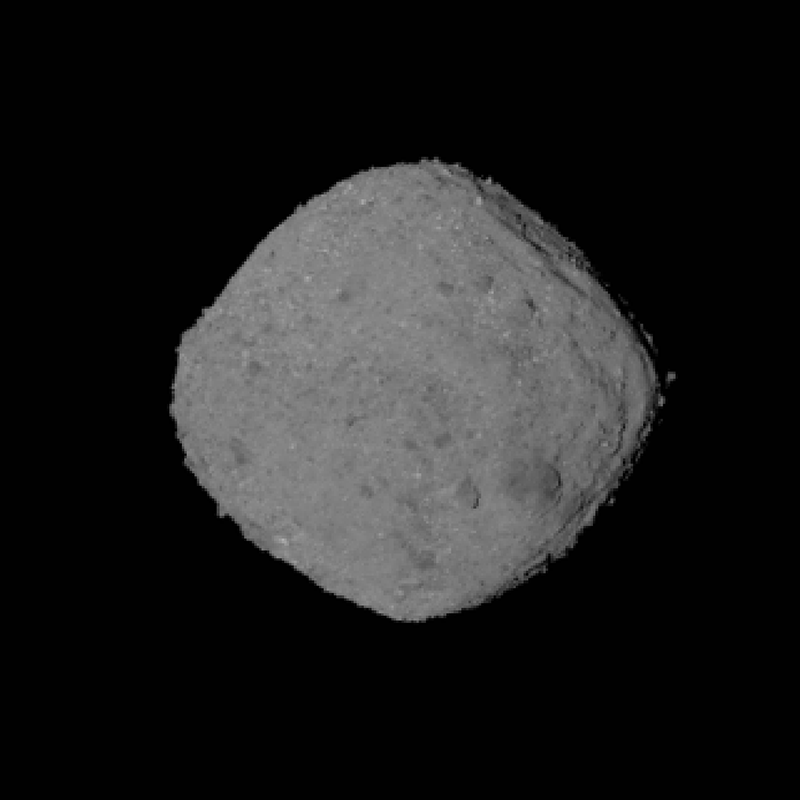September 25, 2023
Bringing home asteroids: Purdue scientist is among the first to examine asteroid pieces from NASA’s OSIRIS-REx mission

Michelle Thompson, planetary scientist and expert in space weathering, is one of the first six humans — and the first woman — to analyze samples of asteroid Bennu brought to Earth by OSIRIS-REx. (Purdue University photo/Rebecca Robiños)
‘Tiger team’ of 6 scientists has 72 hours to get first look at samples from Bennu
WEST LAFAYETTE, Ind. – To study the planets, someone has to go there: Either a human or a bot launches into space to physically explore other worlds. Scientists who study extraterrestrial materials can’t usually bring their work home.
That’s exactly what’s happened this month, though, as NASA’s OSIRIS-REx project brought home pieces of the asteroid Bennu.
Additional Information
- Asteroid explorer collects first samples thought to be rich in organic compounds
- Still taking giant leaps from lunar small steps: Purdue scientists analyze moondust collected by Apollo 17 astronauts
- This solar system rocks: Geologist studies asteroids and moondust to decode the history of the solar system
The culmination of more than a decade of work by a team of thousands, samples of the asteroid landed Sept. 24 in the Utah desert and were whisked off to a clean lab at NASA’s Johnson Space Center in Houston. There, Michelle Thompson, associate professor of earth, atmospheric, and planetary sciences in Purdue’s College of Science, is one of the first six lead investigators from the science team — and the first woman — to study the samples. To protect the sample from contaminants, only the six scientists, clad in bunny suits, gloves, hoods, shoe covers and hair covers, are allowed in the room with the sample.
“This is a truly once-in-a-lifetime — maybe a once-in-several-lifetimes — experience,” Thompson said. “OSIRIS-REx was selected in 2011, the year I started my PhD, and launched in 2016, the year I got my PhD. It reached Bennu in 2018, the year I came to Purdue. And now I am going to be one of the first humans to get to study it. Bennu is a treasure trove of information; this is literally the project of my career.”
Two other missions, Hayabusa and Hayabusa2, both launched by the Japan Aerospace Exploration Agency, have brought asteroid samples back to Earth. However, each of those missions returned much smaller amounts of sample material. Hayabusa brought back less than a milligram — approximately the weight of a single grain of granulated sugar — from the asteroid Itokawa. Hayabusa2 brought back 5.4 grams of material — about the weight of a nickel — from the asteroid Ryugu.
Scientists aren’t yet sure exactly how much material OSIRIS-REx has brought back, but its collection cannister appeared to be packed. The mission’s goal was to return 60 grams of sample. However, from camera observations, there may be more than 100 grams of material: about the weight of a stick of butter or a baby panda. The entire 100-pound capsule was shipped to the cleanroom lab; Thompson and her teammates will open it and measure what they find there.
What’s inside will be enough to keep hundreds of scientists busy for the length of their careers. But, along with five other colleagues, NASA selected Thompson to be one of the scientists to get the first look: They have 72 hours to analyze the samples to inform the science team and the public of their initial characterization.
How’s the weather, whether or not we’re together
Thompson is an expert in how asteroids, moons and other planetary bodies react with space — a process called space weathering. Understanding the surface, the very top few millimeters of rock and dust, called regolith, will shed light on the composition of asteroids and how their properties change and reflect their makeup. She has previously studied samples of moondust brought to Earth by the Apollo missions and has spent months at Johnson Space Center preparing for the asteroid samples’ arrival.
OSIRIS-REx’s name, which stands for Origins, Spectral Interpretation, Resource Identification and Security — Regolith Explorer, encapsulates the program’s goal. Results will help give scientists insight into the origin of the planets and the earliest history of our solar system.
Studying an asteroid’s surface chemistry and how it compares to measurements and observations astronomers can make from Earth or orbital spacecraft will help scientists better understand how to interpret what they see.
“Observing asteroids from spacecraft and telescopes is incredibly important, but nothing can replace analyzing samples in the laboratory,” Thompson said. “Sample return missions are a cornerstone of planetary science, and this close-up look at Bennu material will give us details we couldn’t see from orbit and help us understand how to interpret what we’re seeing on other faraway asteroids. It makes our understanding more comprehensive, more three-dimensional.”
Other motivations include understanding what asteroids are made of to help future humans and explorers find whatever they might need to mine for future vehicles, missions and habitats. Scientists also hope to gain more understanding of asteroids’ physical chemistry and how its orbit is changing with time, particularly of asteroids like Bennu that come close to Earth — and even have a chance, however minuscule, of impacting Earth.
“Asteroids are relics of the early solar system,” Thompson said. “They’re like time capsules. We can use them to examine the origin of our solar system and to open a window to the origin of life on Earth.”
 The mission retrieved samples from Bennu, a carbonaceous asteroid that passes within 186,000 miles of Earth, closer than the moon. This mosaic image of Bennu is composed of 12 PolyCam images collected on Dec. 2 by the OSIRIS-REx spacecraft from a range of 15 miles. (NASA image)
Download image
The mission retrieved samples from Bennu, a carbonaceous asteroid that passes within 186,000 miles of Earth, closer than the moon. This mosaic image of Bennu is composed of 12 PolyCam images collected on Dec. 2 by the OSIRIS-REx spacecraft from a range of 15 miles. (NASA image)
Download image
Bennu is a carbonaceous asteroid, which means that the element carbon — a fundamental building block of life — makes up a part of its composition. Like charcoal, a common carbonaceous material, many of these asteroids are dark and difficult to spot and see well in their entirety. Almost three-quarters of all asteroids are carbonaceous, so information gleaned from Bennu is likely to be applicable to many other asteroids in the solar system.
Asteroid Prime Delivery
Of course, pieces of asteroids can fall to Earth on their own. It’s just that when they do, they don’t get here unscathed. Screaming through the friction of Earth’s atmosphere is a violent process, and not many rocks make it to the surface intact. If they do land in one piece, they can be altered and contaminated by the atmosphere and their surroundings on Earth.
Escorting the rock down, gently and insulated in still-pristine condition, using human innovation, means that scientists will get to look at the asteroid as it was in its original environment, lending understanding to a wide range of planetary science.
“These samples have been on their way back to us for a couple of years,” Thompson said. “We have had years to prepare for what we might find and how we might study the sample.”
Thompson’s expertise in the equipment and protocols of studying the chemistry of very small particles and rock samples gives her an edge in figuring out what elements and compounds make up Bennu’s surface and how that structure might have changed over the history of the solar system.
Earth and other large planets have volcanoes or plate tectonics that have shaped and reshaped their surfaces over the history of our solar system. Asteroids like Bennu have experienced minimal alteration since their formation over 4.5 billion years ago. Analyzing their composition gives scientists hints to what materials might have been present as the solar system and all the planets formed and as life began to move on the surface of Earth itself.
“Looking at the organic molecules from Bennu, we’re going to get an understanding of what kinds of molecules could have seeded life on early Earth,” Thompson said. “Information about what compounds, what elements are there, and in what proportions. We won’t find life itself, but we’re definitely looking at the building blocks that could have eventually evolved into life.”
About Purdue University
Purdue University is a public research institution with excellence at scale. Ranked among top 10 public universities and with two colleges in the top 4 in the United States, Purdue discovers and disseminates knowledge with a quality and at a scale second to none. More than 105,000 students study at Purdue across modalities and locations, with 50,000 in person on the West Lafayette campus. Committed to affordability and accessibility, Purdue’s main campus has frozen tuition 12 years in a row. See how Purdue never stops in the persistent pursuit of the next giant leap, including its first comprehensive urban campus in Indianapolis, the new Mitchell E. Daniels, Jr. School of Business, and Purdue Computes, at https://www.purdue.edu/president/strategic-initiatives.
Writer/Media contact: Brittany Steff, bsteff@purdue.edu
Source: Michelle Thompson, mthompson@purdue.edu

